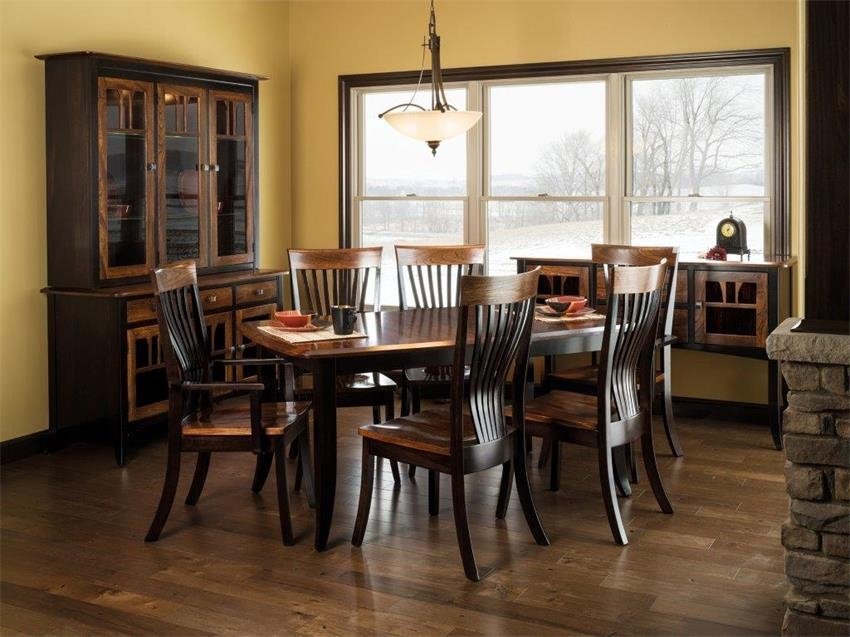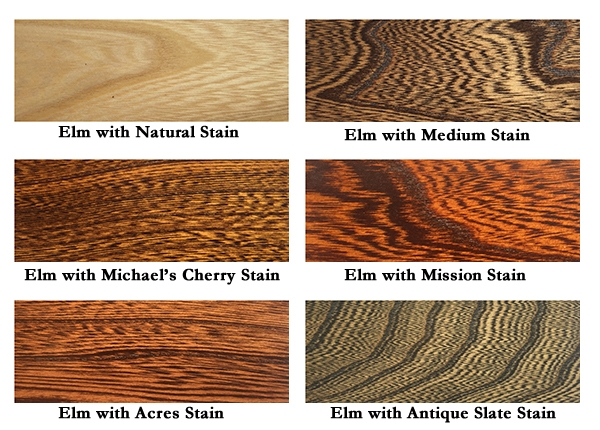Elm Wood Furniture
Elm wood furniture has a showy wood grain that’s unique and bold. The look and hardness of elm wood makes it an attractive option for furniture and furniture parts that need to withstand a lot of stress.

Christy Dining Set in Grey Elm and Brown Maple with Two-Tone Finish
The grain is interlocking and that makes it tough,
But for this unique wood that’s not enough,
The rings create a bold pattern that’s in its own realm,
There’s lots of character in every inch of elm.
What Does Elm Wood Furniture Look Like?
Elm is a beautiful wood with heartwood colors that range from light to medium reddish-brown and a paler sapwood that is off-white in color. Elm wood has a prominent growth ring pattern and interlocking wood grain with a coarse, uneven texture. The interlocked grain features unique swirls and waves that make it stand out.

Is Elm A Hardwood?
Elm wood has a Janka Hardness rating of 830 and is classified as a “soft hardwood,” meaning it’s quite durable and tough, but it is softer than other hardwoods. Elm’s interlocked grain adds to its toughness and makes it more resistant to splitting. It’s highly durable and offers great shock resistance. It’s for these reasons that elm wood can be used for furniture and furniture parts that need to absorb shock.
Note: The Janka Hardness Test measures the force required to embed a .444 inch steel ball half of its diameter into a piece of wood.
How is Elm Used in Furniture?
While elm is tough and hard, it also steam bends easily and then holds its shape well, making it great for supportive furniture parts like frames, backs, seats and legs that need to be structurally strong.
Elm wood glues well and holds nails and screws without issue. It finishes well and stains without much difficulty. Because of the interlocking grain, it is recommended to use power tools to work it to avoid tear out (when wood fibers tear away when cut across the grain). Elm wood is easy to sand for a nice finish.
Other items that the toughness of elm is useful for include:
- Butcher blocks
- Cutting boards
- Chair seats
- Spindles
- Decorative paneling
- Boxes, baskets, barrels and crates
- Caskets
- Hockey sticks
- Wagon wheels
- Tool handles
- Bats
Elm Wood Grain is Rich With Character
The interlocking wood grain of elm furniture doesn’t follow any rules. This type of grain occurs when the fibers of the wood grain reverse their direction as the tree grows. This results in a grain that spirals and swirls with a look that’s not quiet and reserved, but bold and beautiful!
Even though it’s a softer hardwood, elm’s toughness can’t be denied. Elm resists decay when wet and has even been used in ships and piers.
Wood From the Elm Tree
There are more than 30 species of elm trees, and they can be divided in to two groups, hard or soft elms. The most well known are soft elms, including the American elm, the slippery or red elm, and the English Elm.
Elm trees are deciduous trees that grow rapidly, and they can grow up to 140 feet tall. On average mature elms grow between 60 and 115 feet tall with a trunk diameter of 3 to 6 feet. Elm trees are loved for the shade they give. Their growth pattern involves a trunk that breaks in to two or three limbs near the ground level then grows to widen out, creating a nice shade tree.
We’re lucky to still have gorgeous elm wood, because during the second half of the twentieth century, Dutch elm disease spread rapidly. Dutch elm disease is a fungal disease spread by elm bark beetles that destroys elm trees. While Dutch elm can be identified pretty quickly, it has not been eliminated and for this reason, elm trees do not grow as tall and large as they once did.
Is Elm Lumber Expensive?
Elm lumber is modestly priced. The damage done by Dutch elm disease means there are fewer mature trees. Luckily, elm grows quickly, but it’s not as readily available as other woods.

 Samples
Samples